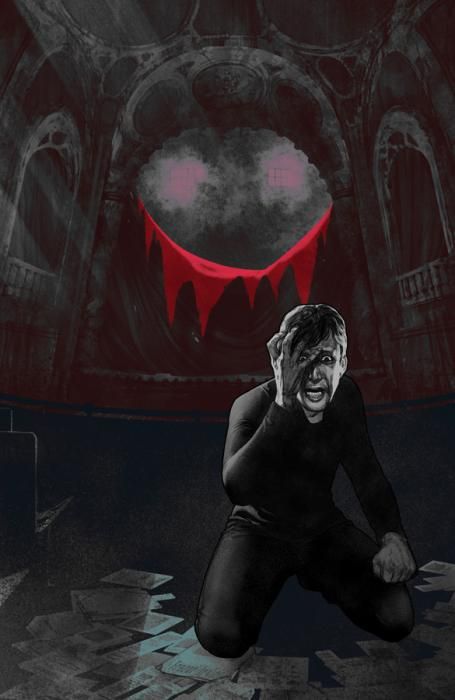"Bedlam" was once a proper noun, the name of a London asylum. "Gone to Bedlam" became shorthand for going insane, and now the word is a synonym for chaos, uproar and madness. In "Bedlam" #1 by Nick Spencer and Riley Rossmo, Bedlam is proper once more, and grown from asylum to city.
"Bedlam" #1 opens with a crescendo-like face-off between hero and villain. After sound and fury, a cinematic, pale sepia and white, double-paged title page greets the reader's eyes. It's beautiful, and it would be like a breath of fresh air, if Bedlam's façade were not also ever so slightly sinister in its withered grandeur. Since "Bedlam" is named after a place, not a person, the city itself will be no wallflower, and I look forward to seeing how Spencer uses it to examine post-industrial, once-great American cities.
The opening also tells the reader what kind of story "Bedlam" will be - horror and mystery, with its feet planted in realism, while donning the sartorial shorthand of superheroes, including the mask, with all the themes of identity and public vs. private that come with that scrap of clothing.
Riley Rossmo's art grasps the polar demands of Spencer's script, moving ably between silence and noise, past and present, television and flesh and blood. In the opening pages, Rossmo draws bedlam -- panic, madness and violence - to operatic effect. Madder Red's choice of an orchestra/theater space for his slaughter is a clever detail, as is his reference to singing.
As a villain, Madder Red outdoes even The Joker in his exultation in the ecstasy of drama and the aesthetics of violence. There's a lot of blood, but gore is not the point, and Rossmo's stylized art is a good fit for Spencer's intentions. The contrasts and simplicity of Jean-Paul Osuka's black, white, red and green palette not only complement Rossmo's art, but further reinforce Spencer's emphasis on theater and its duality of comedy and tragedy.
The Joker and Dexter Morgan are Madder Red's closest criminal cousins, and he combines features of both killers, villain and antihero in one. He has a civilian life, however bare, but he is barely functional within it. He has some vestige of a conscience and is an intellectual. Also, like Sherlock Holmes, human suffering does not motivate him, but problem-solving draws his desire "to help."
Despite being more muted in color and visual sound, the present-day, Fillmore Press parts of "Bedlam" #1 are more memorable and original than those with Madder Red. Spencer's dialogue for Press is spellbinding, and unlike anything he's written before. As Press says his lines, the reader hears his intelligence, his irony, the high pitch of his voice and the excitable, twitchy rhythms of his speech.
When Madder Red/Fillmore Press isn't talking, the story drags, but the press conference and TV voiceovers do advance the backstory.
Rossmo's character design dovetails with Spencer's dialogue. Press' thin physique and large features fit his Joker-like nervous energy, and Rossmo's design of Madder Red costume is a cross between a skeleton and a clown. Appropriately, both "Bedlam" #1 and its antihero have an uncomfortable, macabre sense of humor.
When Press needs to make a phone call, his interaction with a salesman is one of the funniest things I've read all year. Momentarily, Press is a likable oddball, but then Spencer twists things around in the following scene, which is visceral and creepy. Rossmo makes Press' actions believable with facial features, body language and visual rhythm. The response of Press' adversaries is believable, too. Isn't it the things we don't understand, but must acknowledge, that are the most terrifying?
"Bedlam" #1 showcases Spencer's gifts for concept, dialogue and mystery as well as Rossmo's skills with mood and pacing, and it's a promising mix of concept and character, creepy and clever, funny and grotesque.

